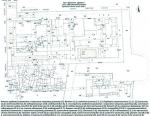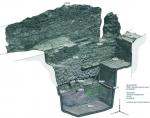Summary (English)
DEULTUM (Hristo Preshlenov – hristo.preshlenov@abv.bg, Milena Raicheva) The excavations of the Temple of the imperial cult continued. At the end of the 3rd century AD, two Rooms of the Roman period were dismantled during the construction of the Late Roman house. The leveling Late Roman layer contained a silver antonianus of Cornelia Salonina. The suspensura of the hypocaust of the Late Roman house was discovered. The floor was constructed of bricks paved with marble slabs placed over a mortar layer, with marble socle. The suspensura consisted of terracotta tubulae 26 cm in diameter and 79 cm in height. The bottom of the hypocaust was paved with bricks and its walls were covered with hydraulic plaster. Coins from the end of the 1st century BC to mid 5th century AD were found, including coins of the Thracian King Rhoimetalkas I, Domitian, Maximian of AD 293 and Arcadius. The debris of the hypocaust destroyed after AD 401/403 contained capitals, socle, plates, fragments from inscriptions, window frames, coins of the Late Classical, Roman and early Byzantine periods, including coins of Maroneia of 398 – 200 BC, Hadrian of AD 125 – 128, Gordian III and Claudius Gothicus of AD 268 – 270. The layer over the hypocaust contained roof-tiles, marble architectural fragments, bronze and silver coins, including coins of Faustina the Elder of AD 141, a colonial bronze coin of Caracalla minted in Deultum in AD 212 and Aurelian. An Early Byzantine building was constructed over the debris, occupied during the first half of the 5th century AD. An Early Byzantine building was also constructed over the northern half of the decumanus. Coins of Constantius II of AD 337 – 340 and Julian were found. The cistern built of bricks measured 3.80/4 m by 1.85/1.90 m and was 1.35 m deep. Its walls were plastered with hydraulic mortar. After the cistern was abandoned, it was filled with bricks, roof-tiles, burned pieces for wood, nails, iron wedges, terracotta tubulae of hypocaust, marble fragments from columns, socle, window frames and veneer, fragments from marble and bronze statues, coins of Antoninus Pius, Gordian III, Philip II, Arcadius and Honorius.
- Hristo Preshlenov - Archaeological Institute with Museum
- Milena Raicheva - Archaeological Institute with Museum
Director
- Hristo Preshlenov - Archaeological Institute with Museum
- Milena Raicheva - Archaeological Institute with Museum
Team
Research Body
- Archaeological Institute with Museum






![Download [PDF]](/excavation/skins/fasti/images/results/download_sml.png)
